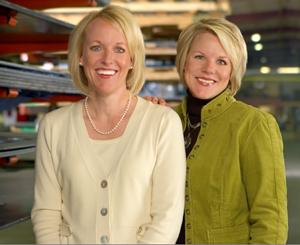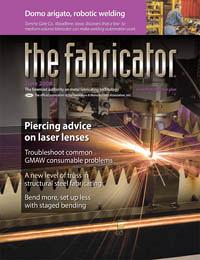Senior Editor
- FMA
- The Fabricator
- FABTECH
- Canadian Metalworking
Categories
- Additive Manufacturing
- Aluminum Welding
- Arc Welding
- Assembly and Joining
- Automation and Robotics
- Bending and Forming
- Consumables
- Cutting and Weld Prep
- Electric Vehicles
- En Español
- Finishing
- Hydroforming
- Laser Cutting
- Laser Welding
- Machining
- Manufacturing Software
- Materials Handling
- Metals/Materials
- Oxyfuel Cutting
- Plasma Cutting
- Power Tools
- Punching and Other Holemaking
- Roll Forming
- Safety
- Sawing
- Shearing
- Shop Management
- Testing and Measuring
- Tube and Pipe Fabrication
- Tube and Pipe Production
- Waterjet Cutting
Industry Directory
Webcasts
Podcasts
FAB 40
Advertise
Subscribe
Account Login
Search
Accounting for growth in lean manufacturing
Job shop complements continuous improvement with lean accounting
- By Tim Heston
- June 17, 2008
- Article
- Shop Management
Lori and Traci Tapani aren't your typical metal fabrication shop managers. Traci came from the world of corporate finance; Lori is a certified public accountant. About 15 years ago the sisters joined their father at Stacy, Minn.-based Wyoming Machine, about 40 miles north of the Twin Cities. A few years later they took the reins as co-presidents.
Early on the two started the company down the path of lean manufacturing, working hard to eliminate a warehouse of finished-goods inventory; streamline part flow through the company's lasers, turret punches, and press brakes; and cross-train employees so they could clear bottlenecks and constraints as needed.
Customer demand now triggers manufacturing. "In the beginning, we may have had a job order come in 12 weeks ahead," Traci said. "But the actual amount of time that we were working on a job and applying value to it—if it didn't have an outside service like painting or plating—was about four days." Today nothing hits the manufacturing floor until it needs to in order to meet the delivery date.
With their finance background, the Tapanis embraced something else that's been far less pervasive in U.S. manufacturing, and even rarer in job shops like 55-employee Wyoming Machine: a concept called lean accounting.
"With traditional accounting, inventory is a good thing," Lori said. "So I knew, after we started our lean implementation, we were going to take a big hit on our income statement. The first few months transitioning to lean production were very difficult. We had a 30 percent reduction in inventory, which transferred to a minus on our income statement. The good thing was I was aware it was coming. After the initial drastic inventory reductions, you don't have those huge hits anymore."
Success came to Wyoming not only because the company followed lean principles, Lori said, but also because the company co-presidents knew about lean's financial impacts—the bottom line wouldn't improve immediately. Lean, they said, frees capacity, allows a company to grow more competitively, and puts cash front and center.
The importance of cash represents a core lean-accounting concept, according to consultant Brian Maskell, president of Cherry Hill, N.J.-based BMA Inc. "Every time you reduce inventory, you will take a hit on your profit for that month," he explained. "It's a piece of accounting witchcraft, really. If you make a product and put it in finished goods, you value it based on the total calculated cost of the product, and the cost of that includes your materials and overhead."
The negative financials can come as a shock during the initial inventory reduction. "When you ship that finished-goods inventory, the labor and overhead [used to make those products in the first place] are accrued to the current month's costs." At the same time, shop labor is making products that are shipping that same month, "so you really have a double accounting of labor and overhead, which makes your manufacturing expenses look terrible," Maskell said.
On top of this, he said, lead-time diminishes. Customers soon realize this and start placing orders closer to the due date, which also negatively affects the financials. Consider a company that reduces lead-time from six weeks to one week. Over time customers realize they don't need to place orders so early; instead of placing an order six weeks ahead, they now wait until a week before the due date. That means those placed orders don't make their way to the balance sheet as early as they once did.
"Imagine if I'm a CFO, and I'm being told how wonderful lean is, but the savings being touted by the operations people aren't making it to the bottom line," Maskell said. "My costs start going up and my profitability is going down. Traditional accounting systems can't see why this happens."
During the early stages of lean, the balance sheet shows less revenue tied up in inventory and orders, so the bottom line doesn't look as favorable in the short term. However, once the initial drop in inventory happens, and a company frees up and uses its extra capacity, the balance sheet will show lean manufacturing's benefits.
Traditional accounting basically looks at inventory and orders as "future cash," but the cash hasn't been realized yet. Lean manufacturing shortens the time between paying for material and labor and getting cash for the finished product. This simplifies the entire business and moves real cash to the footlights—and in business, real cash is, of course, what really matters.
As Lori put it, "It's not a positive thing for your cash if your income is high just because you build a bunch of inventory."
With inventory minimized and orders coming days—not weeks—before customers need the finished product, lean accounting turns its attention to measuring a value stream's ability to produce capacity. The more efficiently a company can increase and fill extra capacity, the more it can grow with lean manufacturing.
Like many metal fabricators, Wyoming Machine experienced tough times during the recession earlier this decade. But thanks to lean concepts, Lori said, the company came out ahead.
Today the metal fabricator makes about as much revenue as it did during the late 1990s heyday, but with about 30 fewer employees. Head count reductions, she added, mainly came about through attrition. Today each employee adds more value to the business.
For Wyoming, the growth is just beginning, Lori said. Over the years, with inventory minimized and part flow tweaked, lean manufacturing has continually freed up more capacity.
"We've done a study, and we've determined we could just about double [our revenue] and not expand our building," Lori said. "We're ready to grow the business."
About the Author

Tim Heston
2135 Point Blvd
Elgin, IL 60123
815-381-1314
Tim Heston, The Fabricator's senior editor, has covered the metal fabrication industry since 1998, starting his career at the American Welding Society's Welding Journal. Since then he has covered the full range of metal fabrication processes, from stamping, bending, and cutting to grinding and polishing. He joined The Fabricator's staff in October 2007.
subscribe now

The Fabricator is North America's leading magazine for the metal forming and fabricating industry. The magazine delivers the news, technical articles, and case histories that enable fabricators to do their jobs more efficiently. The Fabricator has served the industry since 1970.
start your free subscription- Stay connected from anywhere

Easily access valuable industry resources now with full access to the digital edition of The Fabricator.

Easily access valuable industry resources now with full access to the digital edition of The Welder.

Easily access valuable industry resources now with full access to the digital edition of The Tube and Pipe Journal.
- Podcasting
- Podcast:
- The Fabricator Podcast
- Published:
- 04/16/2024
- Running Time:
- 63:29
In this episode of The Fabricator Podcast, Caleb Chamberlain, co-founder and CEO of OSH Cut, discusses his company’s...
- Trending Articles
Steel industry reacts to Nucor’s new weekly published HRC price

How to set a press brake backgauge manually

Capturing, recording equipment inspection data for FMEA

Are two heads better than one in fiber laser cutting?

Hypertherm Associates implements Rapyuta Robotics AMRs in warehouse

- Industry Events
16th Annual Safety Conference
- April 30 - May 1, 2024
- Elgin,
Pipe and Tube Conference
- May 21 - 22, 2024
- Omaha, NE
World-Class Roll Forming Workshop
- June 5 - 6, 2024
- Louisville, KY
Advanced Laser Application Workshop
- June 25 - 27, 2024
- Novi, MI



























